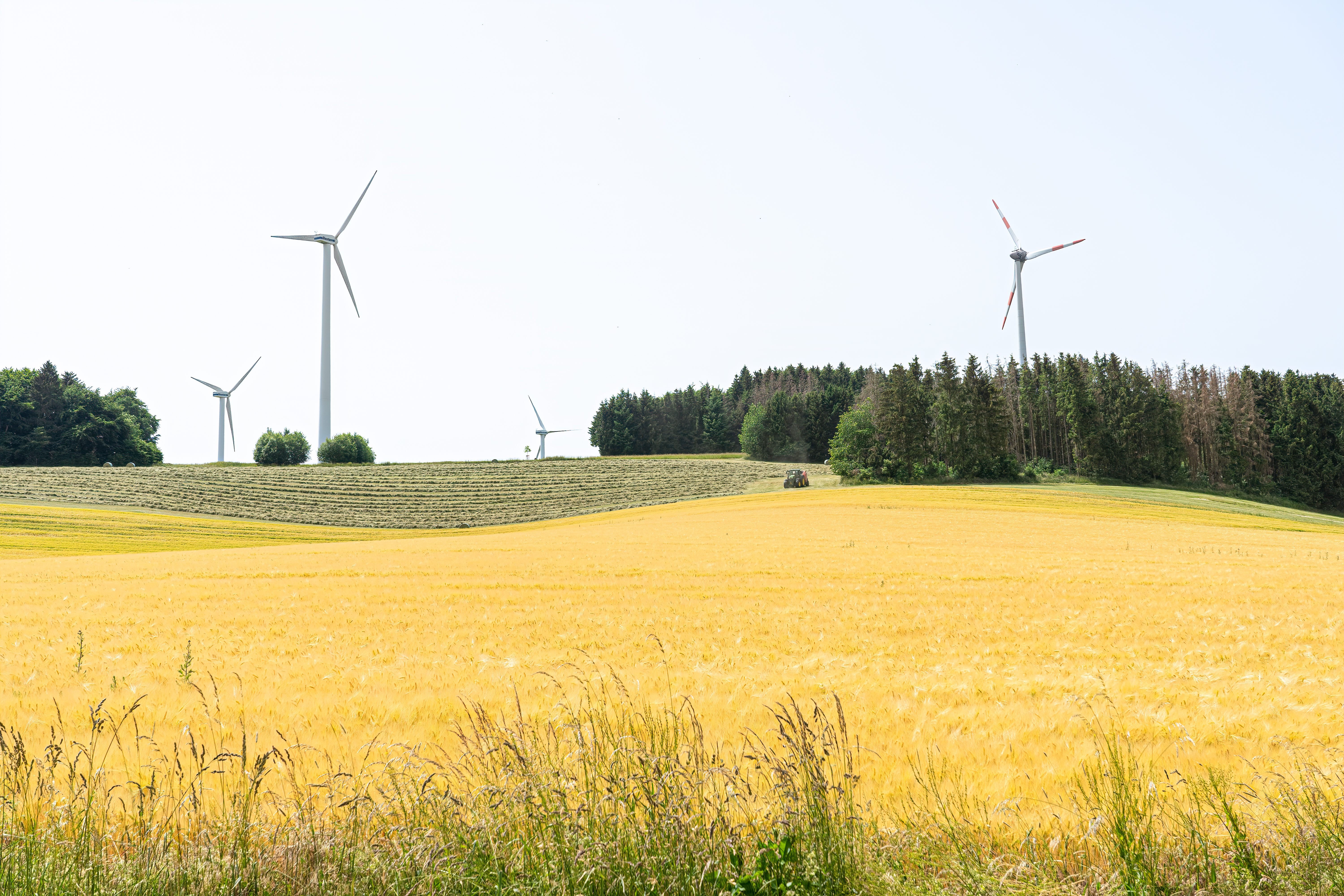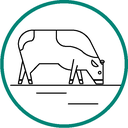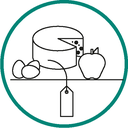The agriculture sector is addressed in line with the definition of the GHG inventory when discussing GHG emissions. This includes looking at all sectors affected by agricultural policies (agriculture, land use, land use change and forestry (LULUCF), energy and waste) when discussing agricultural policies.
The agri-food system looks at the full food value chain. This covers everything from the design and production phases to the consumption and waste management phases. Seafood and aquaculture are excluded from the scope of this study.

© Designed by Tobias Terman Olsen
Substantial efforts are needed across Europe to further reduce greenhouse gas emissions in agriculture
As a Party to the United Nations Framework Convention on Climate Change (UNFCCC), the EU reports annually on GHG emissions and removals within the area covered by its Member States. The key sources of agricultural emissions included in GHG inventories are:
-
methane and nitrous oxide (N2O) from livestock (manure management and enteric fermentation);
-
N2O from agricultural soils;
-
CO2 from energy combustion (off-road vehicles, fishing boats, greenhouses);
-
CO2 from land use and land use changes in cropland and grassland.

Agriculture accounts for 11% of the total domestic annual GHG emissions of the 27 EU Member States (EU-27) (EEA, 2022a; EEA, 2022b). The greatest contributor of non-CO2 emissions to this 11% is methane, which comes from enteric fermentation in livestock (accounting for 43% of total agricultural emissions in 2020). N2O emissions from agricultural soils also represent a substantial share (38% of total agricultural emissions in 2020), largely due to fertiliser application. Livestock manure management is the third-largest contributor, producing methane and N2O (15% of total agricultural emissions in 2020). These contributions are illustrated in Figure 1.
Note: Other categories: 3C. Rice cultivation, 3E. Prescribed burning of savannas, 3F. Field burning of agricultural residues, 3G. Liming, 3H. Urea application, 3I. Other carbon-containing fertilizers, 3J. Other.
Click here for different chart formats and data
As Figure 1 illustrates, GHG emissions from agriculture have been relatively constant since 2005 (EEA, 2022b). During this period, the production of several animal and crop products — including milk, poultry meat, pork and oilseeds — has increased (ETC/CME, 2021)[1].
These increases in agricultural production significantly drive overall emission levels. Despite reductions in the emission intensity of production for some products at the EU level — that is, in the level of GHGs emitted per unit of product — emissions have remained relatively stable over the last couple of decades. For instance, between 2000 and 2019, the level of enteric fermentation per litre of milk produced declined by 17% due to changes in dairy cattle management practices. However, increases in milk production have counterbalanced the positive effects that these practices have had on overall emission levels. Without the changes in dairy cattle management practices, emissions would have risen alongside production (ETC/CME, 2021)[2].
Reductions in emissions between now and 2040 are projected to be too insignificant to help the EU become climate neutral by 2050. EU Member States’ efforts to reduce GHG emissions in the agriculture sector are reflected in national policies and measures — both those currently being implemented and those planned. National policies and measures currently in place across the EU are expected to deliver only a 1.5% reduction in agricultural emissions between 2020 and 2040. If policies and measures that are currently planned are implemented, a slightly larger decrease — but only of 5% — is projected (ETC/CME, 2021).
In 2021, the EEA analysed the agricultural policies and accompanying measures that EU Member States have put in place to reduce their GHG emissions. These policies and measures also covered the sectors land use, land-use change and forestry (LULUCF) and bioenergy, and the wider food system (ETC/CME, 2021).
The study demonstrated that the impact of policies and measures depends on the types of measures incentivised as well as their uptake. Out of 292 relevant, reported policies and measures, the majority had an economic or regulatory dimension; ‘softer’ measures such as education or research were less common. Since agriculture in the EU-27 is strongly influenced by the CAP, it is not surprising that over half of the reported measures were related to it, as well as the Nitrates Directive and Effort Sharing legislation.
Table 1 illustrates, for five focus areas, the most frequently-reported measures (EEA, 2022c; EEA, 2022d). It also reflects the ‘gaps’ in the landscape of policies and measures, where approaches that could aid climate mitigation are only minimally represented, if at all (Perez-Dominguez et al., 2016; Ricardo-AEA, 2016; ECA, 2021).
| Focus area | Most frequently-reported measures | ‘Gaps’ in reported measures |
|---|
|
Livestock

|
Optimising livestock diets, breeding, health and disease management; improving manure management systems; and promoting anaerobic digestion ‘biogas’. |
Reducing livestock numbers is still uncommon. Supporting targeted breeding and using feed additives to reduce enteric methane emissions are rare, and these measures are mostly yet to be implemented. |
|
Reduction in crop and soil N2O

|
Reducing the quantity of nitrogen applied to soils, using low emission-spreading equipment, supporting organic farming and introducing organic fertilisers. |
Support for nitrification or urease inhibitors is rare, despite their potential efficacy. Precision farming allowing more effective use of inputs (e.g. variable-rate nitrogen technology, pesticide application and precision irrigation) is also lacking. |
|
Carbon storage/sequestration

|
Maintaining or enhancing woody biomass on farmland (e.g. through agroforestry), implementing grassland management to enhance soil carbon stocks, using cover crops and conserving organic soils. |
Explicit support for permanent conversion of arable land to grassland or wetland, including ponds where appropriate, is lacking. This would limit drainage and restore carbon-rich ecosystems, and incentivise sustainable soil management. |
|
Energy mitigation

|
Improving on-farm energy efficiency, excluding measures relating to biogas (this is covered as a manure management measure). |
Carbon-auditing tools are not frequently mentioned, despite their high mitigation potential. |
|
Wider food system

|
Awareness-raising and education among consumers, food labelling and repealing the waste status of by-products to allow use/reuse as a resource were measures proposed to encourage dietary shifts and reductions in food waste. Some Member States included plans to reduce reliance on imports by increasing domestic food and animal feed production. |
Relatively few countries reported measures to encourage dietary change, shortening supply chains or reductions in food waste (e.g. through improvements in food redistribution systems, financial mechanisms supporting reductions in food waste, registration and monitoring of procedures). |
Note: Information on the most frequently-reported measures is based on the information reported to the EEA under the governance regulation (Regulation (EU) 2018/1999) on GHG policies and measures.
Sources: Gaps in reported measures were identified based on Perez-Dominguez et al. (2016), Ricardo-AEA (2016) and ECA (2021).
Farmers embracing more measures could help further reduce emissions, but some barriers exist
Among the policies and measures in place, the study also looked more closely at factors that can prevent their full uptake or the maximisation of their potential to reduce agricultural GHG emissions (ETC/CME, 2021). The experiences of national and international agriculture experts, captured through a questionnaire and interviews, provided valuable insights for understanding the key challenges.
Table 2 provides an overview of the barriers that farmers and other stakeholders face when it comes to implementing new policies. At the same time, the CAP 2023-2027 could help overcome some of these barriers.
|
Barriers
|
Opportunities
|
| At the farmer level |
|
High capital costs of infrastructure improvements (manure stores, housing, biogas facilities). This is a problem for smaller farms without sufficient subsidies.
|
Investment support or communal facilities.
|
|
Farmer knowledge. A lack of awareness around GHG emission sources and their impacts among farmers is a problem. In tandem, farmers lack sufficient information, training and advisory services.
|
Climate change mitigation and adaptation training financed by the CAP 2023-2027.
|
|
Generational renewal. The low numbers of young farmers entering the sector inhibits the spread of new practices.
|
Making agriculture more attractive to young people and encouraging them into farming by facilitating start-up grants, income support and training.
|
|
Limited access to information technology (IT) infrastructure and poor IT literacy. Better access and literacy are needed to take advantage of information available online and digital support tools.
|
Digitalisation and other innovations in line with EU policy priorities. Additional training for farmers financed by the CAP 2023-2027.
|
|
Complex rules regarding subsidies and incentives.
|
Simplification of the CAP and further work/reform. Implementing CAP 2023-2027 will open new options for further discussion.
|
|
Conflicting policy objectives. The production-maximising mindset some farmers have makes them less receptive to some mitigation schemes.
|
More research on policy effectiveness to allow tailored and high-quality advice to be given to farmers. More inclusive discussions with farmers about the ways in which mitigation measures affect production.
|
| Non-farmer level |
|
Knowledge gaps and policy applicability. Issues in relation to this can arise as a result of the specificity of agricultural production, and its dependence on the climate and other environmental conditions.
|
Cooperation, exchange of best practices among similar cases and integrated assessments of a wide range of policy effects.
|
|
Farm structure (i.e. lots of small farms that are highly disaggregated) in some parts of Europe. This compounds issues associated with investment costs and access to training.
|
Cooperation and a collective/group approach, promoted under the CAP. This is a good way to encourage small farmers to work together, which contributes to administrative simplification and cost reduction.
|
|
Monitoring impact. There is a lack of country-specific evidence of the impact and cost of mitigation measures, and emissions inventory methods are also unable to reflect these impacts.
|
Further work on inventory accuracy is needed and is being called for by many policy makers.
|
Both farmers and non-farmers can contribute to emission reductions through the circular economy
While farmers can contribute to reducing GHG emissions from agricultural production, other stakeholders in the agri-food system must also play a role. There is untapped potential to reduce waste and promote practices consistent with the circular economy across the full life cycle of food production and consumption. In addition, farmers can increase the sequestering of carbon by applying specific agricultural practices. This would foster a more effective reduction in GHG emissions from agriculture and the agri-food system, and help the sector move closer to climate neutrality.
To better identify which circularity actions could provide the greatest opportunities for further, sustained emission reductions in Europe’s agri-food system, a second study commissioned by the EEA highlighted some opportunities for improving material flows while also reducing GHG emissions (Metabolic, 2022)[3].
The study evaluated 17 selected actions that could reduce GHG emissions at each stage of the agri-food life cycle — from the design and production of agri-food products to consumption (use) and waste handling (end of life) (see Figure 2). Reducing the overall demand for resources, preventing waste generation or using resources in a circular, stable way could all help reduce GHG emissions from the agri-food system and increase agriculture’s capacity to sequester carbon.
Note: The evaluation of selected circularity actions builds on the best available data. Because of variations in the data sources (particularly the carbon sequestration actions), some uncertainties remain in the final calculations.
Click here for different chart formats and data
The study illustrated that, in the design phase, changes to the composition of food products, the way they are processed and dietary choices all affect the land system and resulting GHG emissions. Actions related to dietary choices, resource use and waste streams all have the potential to reduce the sector’s climate impact by avoiding GHG emissions later in the life cycle. In the use phase, preventing food waste generation can reduce emissions in farm, commercial and domestic environments. In the end-of-life phase, repurposing waste products, such as food waste, or capturing CO2 emissions in industrial greenhouses could also meaningfully reduce GHG emissions.
In the agricultural production phase, actions that increase carbon sequestration can maintain and enrich carbon stores in situ. While a realistic scale of carbon storage through agroforestry would be lower than the maximum technical potential illustrated in Figure 2, the study highlights the importance of further exploring how sequestering actions such as agroforestry could contribute to the carbon sink. Actions such as silvopastoralism or the optimisation of grazing patterns, which both store further carbon in pasture systems, also show major technical potential.
All stakeholders can contribute to achieving climate-neutral agriculture and a climate-neutral agri-food system
Agricultural production is one of the central elements of the agri-food system and remains a significant source of GHG emissions. The studies presented in this briefing suggest the areas where existing policies are active and address the sources of reported GHG emissions. They also illustrate where introducing new, transformative or expanded measures could enhance emission reductions from agriculture and the agri-food life cycle.
In terms of climate mitigation, there is often heavy focus on the roles of farmers — the efforts they make and their uptakes of measures. However, the engagement of all stakeholders — including consumers, processors, retailers and policymakers — can also significantly help the agri-food system transition to climate neutrality.

Notes
[1]The study (1) addresses the agriculture sector in line with the definition of the GHG inventory when discussing GHG emissions; and (2) has a broader agricultural perspective, including looking at all sectors affected by agricultural policies (agriculture, land use, land use change and forestry (LULUCF), energy and waste) when discussing agricultural policies. The agriculture sector interacts with the waste and energy sectors by, for example, providing a means of disposal for sewage sludge, being a source of biomass for bioenergy and land for solar photovoltaics and being a consumer of fossil fuels. The scope of information in ETC/CME (2021) is as follows: GHG emissions, projections and policies and measures reported by EU countries under the Monitoring Mechanism Regulation (Regulation (EU) No 525/2013) and the Governance Regulation (Regulation (EU) 2018/1999); literature-based research; and survey responses and interviews.
[2]Member States’ reporting on policies and measures have generally omitted any quantification of policies’ impacts (which are required only if available). This means that a quantitative analysis of expected policy impacts could not be carried out.
[3]There is a difference in the sectoral scope of the Metabolic (2022) study and that of the ETC/CME (2021) study. The scope of the study on circular economy actions (Metabolic, 2022) includes the agri-food (agriculture and food) system and looks at the full food value chain. This covers the design and production phases through to the consumption and waste management phases. Seafood and aquaculture are excluded from the scope of this study.
References
ECA, 2021, Common agricultural policy and climate: half of EU climate spending but farm emissions are not decreasing, Special Report 16/2021, European Court of Auditors (https://www.eca.europa.eu/Lists/ECADocuments/SR21_16/SR_CAP-and-Climate_EN.pdf) accessed 12 September 2022.
EEA, 2022a, Annual European Union greenhouse gas inventory 1990-2020 and inventory report 2022, European Environment Agency(https://www.eea.europa.eu/publications/annual-european-union-greenhouse-gas-1) accessed 12 September 2022.
EEA, 2022b, ‘EEA greenhouse gases — data viewer’, European Environment Agency (https://www.eea.europa.eu/data-and-maps/data/data-viewers/greenhouse-gases-viewer) accessed 26 June 2022.
EEA, 2022c, ‘EEA database on greenhouse gas policies and measures in Europe’, European Environment Agency (http://pam.apps.eea.europa.eu/ ) accessed 26 June 2022.
EEA, 2022d, ‘EEA data viewer on greenhouse gas policies and measures in Europe’, European Environment Agency (https://climate-energy.eea.europa.eu/topics/climate-change-mitigation/policies-and-measures-to-reduce-emissions/data) accessed 26 June 2022.
ETC/CME, 2021, Agricultural climate mitigation policies and measures: good practice, challenges, and future perspectives, ETC/CME Eionet Report 6/2021, European Topic Centre on Climate Change Mitigation and Energy (https://www.eionet.europa.eu/etcs/etc-cme/products/etc-cme-reports/etc-cme-report-6-2021-agricultural-climate-mitigation-policies-and-measures-good-practice-challenges-and-future-perspectives) accessed on 12 September 2022.
Metabolic, 2022, Circular agrifood. Potential of circular economy actions to reduce greenhouse gas emissions (https://www.metabolic.nl/publications/circular-agrifood/) accessed on 28 September 2022.
Perez-Dominguez, I., et al., 2016, An economic assessment of GHG mitigation policy options for EU agriculture (EcAMPA 2), JRC Science for Policy Report, EUR 27973, Joint Research Centre of the European Commission (https://publications.jrc.ec.europa.eu/repository/handle/JRC101396) accessed 12 September 2022.
Ricardo-AEA, 2016, Effective performance of tools for climate action policy — meta-review of common agricultural policy (CAP) mainstreaming, report for the Directorate-General for Climate Action of the European Commission.
Identifiers
Briefing no. 17/2022
Title: Progress and prospects for decarbonisation in the agriculture sector and beyond
EN HTML: TH-AM-22-018-EN-Q - ISBN: 978-92-9480-502-7 - ISSN: 2467-3196 - doi: 10.2800/777490
EN PDF: TH-AM-22-018-EN-N - ISBN: 978-92-9480-503-4 - ISSN: 2467-3196 - doi: 10.2800/494497








Document Actions
Share with others